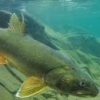Nick, it may just be coincidence, I don't know. It isn't an "all the time" behavior, usually one that occurs when fish new to each other are mixed or when tank furniture gets rearranged. That's what had me thinking it may be territorial. But it never seems threatening- it's almost more of a "getting to know you thing". But I just can't imagine any fish ever rolling out the welcome wagon; so it's back to assuming somehow it's territorial. Considering there is usually a fair number of darters in the tank, mostly but nowhere near all E. hopkinsi, the hubub of adding new fish or rearranging the tank may just have them out of their routine, running around more than normal, and in physical contact more than normal. But the incident that got me to finally ask about this was no accident; so at least in that case it wasn't a matter of a clumsy hopkinsi running into another fish. Also, the fact that every time I've noticed it the contact has been head to head, not head to midsection or head to tail, etc. has me thinking it's intentional.
Michael, I didn't do the best job describing that, did I? I'll try to be a little more specific. My 55 has a large pile of medium sized rocks under the outflow of my hob. A current generating "fan" adds considerably to the water movement. It's a little bit rough under there. The other end is an open, sandy bottom. No plants. A reasonable current, but not as vigorous as under the outflows.
Yesterday morning the darter population consisted of E. hopkinsi, in a fairly large number; one decent sized E. inscriptum, and a P. crassus. You are correct in that nobody messes with the inscriptum. Every once in a while he flares up and chases somebody else away from his favorite area; so it's obvious when he's being aggressive and just what it is that has him miffed. He likes his space. The hopkinsi on the other hand have always been more social, with other hopkinsi of the same size. The smaller ones in particular will hang out in pretty close company, often times touching. Whether this is normal or the result of living in an artificial environment, I have no idea. (Need to get some snorkelers on it!

) While small ones engage in this the most, large ones do every once in a while.
Yesterday evening I introduced four thalassium of sizes varying from smallish to Big. Also introduced four small flabellare/brevispinum. The fantails promptly headed for the rockpile and haven't been seen since. The thalassinum spent a good deal of time scampering around the rocks, probably failing in an effort to try to find familiarity and a sense of security. All the previous inhabitants were much more energetic and mobile than normal as a result of all the activity. One thalassinum, easily at the top of their size range, is currently the biggest darter in the tank. He settled down fairly quickly, while the other seagreens kept flailing about. He found a spot in the current, with a little bit of floor space and rock raising up above him on three sides. A smallish hopkinsi was on the very outskirts of this "hole", on the leeward of a rock. After the seagreen had settled in, this hopkinsi (who was much smaller than the seagreen) swam directly to the seagreen's head and placed its head on top of it. (To be clear, the hopkinsi initiated the contact, intentionally, by placing its head on top of the seagreen's.) It was kinda funny because the Christmas darter had to stretch a bit to get its head up there! No further action took place after this contact. They remained like this for half a minute or so, and then the hopkinsi backed off to its original place.
As of this morning, the thalassinum is no longer in that spot, but has found another one in the corner of the tank where the current blows through. It will be interesting to see what happens at feeding time if he remains there; it is a favorite spot of about five hopkinsi who are on the lower end of the size/dominance scale for their species in my tank.












